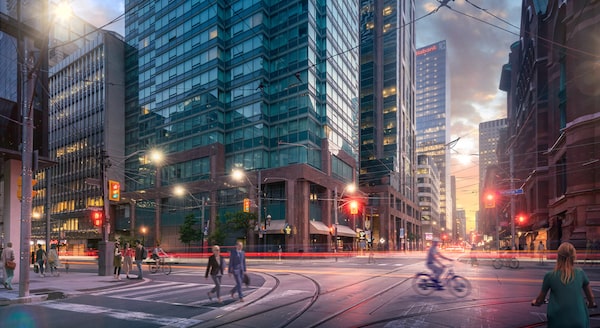
The development proposal for the 21-storey property on Richmond Street East starts with the removal of the 1990 post-modern building’s peaked roof.
The architects and builders redeveloping Cambridge Suites Hotel at the edge of Toronto’s financial district say their plan is going to take construction techniques in the city to a whole new level. It looks like they’re not exaggerating.
The development proposal for the 21-storey property on Richmond Street East near the city’s soaring bank towers starts with the removal of the 1990 postmodern building’s peaked roof.
In its place will be an additional 50 storeys, bringing the new project to a height of 757 feet (230.85 metres), head-to-head with neighbours such as the Toronto-Dominion Centre (731 feet).
It’s a complicated project that will require a 10-metre-high bridge structure to be built atop the existing hotel where the roof is removed. The bridge will help bear the weight of the new tower, explains Len Abelman, principal at Toronto’s WZMH Architects, the firm designing the redevelopment for the property’s owner, Centennial Hotels Ltd.
“It’s not a common technique, it’s challenging. We worked with a firm called RJC Engineers to do simulations of the massing and loading of weight and the lateral forces the building will face, to make sure it will work,” Mr. Abelman says.
“Other projects in Toronto have added floors before, but it’s usually done with a big exoskeleton that goes over the entire building. This one uses technology that transfers some of the weight to the columns and the floors of the existing structure below,” he says.
The site’s hotel, which currently offers 231 suites for business travellers, will be turned into 565 residential units with retail and commercial businesses at ground level; 42 per cent of the units will be two- or three-bedroom units to meet the city’s requirement for more family-sized downtown accommodation.
In September, the developers commissioned Bousfields Inc. to prepare a planning rationale document as they are seeking zoning and Official Plan amendments from the City of Toronto.
Bousfields explains that the current hotel is within an area of downtown Toronto that the city has designated as a “strategic growth area … for accommodating intensification and higher-density mixed uses in a more compact-built form.”
Return to office
The long-term idea is to redevelop downtown properties such as Cambridge Suites to reflect changing patterns in the way people live and work. As the pandemic ebbs and flows, people are slowly drifting back to the office, but it’s not quite a stampede.
As of mid-August, the percentage of people going to offices in Toronto was still 30 per cent of pre-pandemic levels, according to the Strategic Regional Research Alliance (SRRA), an independent research group that keeps tabs on changing work patterns.
“Putting more housing in the financial core is a real act of city-building. It will make a difference to the people who live and work there,” says Alan Vihant, president of Elan DEV Group and a spokesperson for the developers’ consortium.
“And we think there’s a way to do it by repurposing the existing building and augmenting it.”
The city’s own growth plan calls for more urban neighbourhoods that would allow for people to live near their work and get around without cars. The Cambridge Suites property is within 800 metres of six Toronto Transit subway stations, including Yonge/Queen and Union Station, which will eventually become transfer hubs for new lines.
“People are starting to come back to offices at least for three or four days a week. But they don’t want long commutes to get there, " Mr. Vihant says.
Like virtually all new commercial construction nowadays, the new project aspires to meet better environmental and sustainability standards than older buildings. According to Natural Resources Canada, 13 per cent of Canada’s greenhouse gas emissions come from the building sector, the third- largest source of emissions.

There will be an additional 50 storeys to the current Richmond Street East building, bringing it head-to-head with neighbours such as the Toronto-Dominion Centre.
Environmental benefits
The new tower will be more thermally efficient than the existing building and will feature bird-friendly glass and 41 square metres of green roof, says Michael McClelland, founding principal of ERA Architects, also working on the project. The project will have only 21 spaces for cars, compared with more than 570 spaces for bicycle parking.
However, Mr. McClelland cautions that the building won’t officially be a fully state-of-the-art green building because it’s incorporating the existing hotel structure into the design.
This construction technique brings other environmental benefits though; using the existing building as a weight-bearing base rather than tearing it down helps address climate change by retaining embodied carbon in the building material.
This reduces the emissions that would result from tearing down the existing structure and replacing it with a new building.
“There is nothing in the city’s current guidelines about retaining embedded carbon yet, but Toronto and other cities are catching up to this idea as they develop new sustainability rules,” Mr. McClelland says.
His firm was also asked to look at any heritage considerations that might arise from reimagining the site, he adds. But the building is only 42 years old so it is not particularly iconic or emblematic, he says.
It will likely take about 18 months to complete the zoning process with the city and up to six years to complete the project, Mr. Vihant says. But WZMH’s Mr. Abelman says the redevelopment is already embracing the future.
“This weight-bearing technology we’re using is the technology of the 2020s – I’m not sure it would have been possible even a few years ago,” he says.